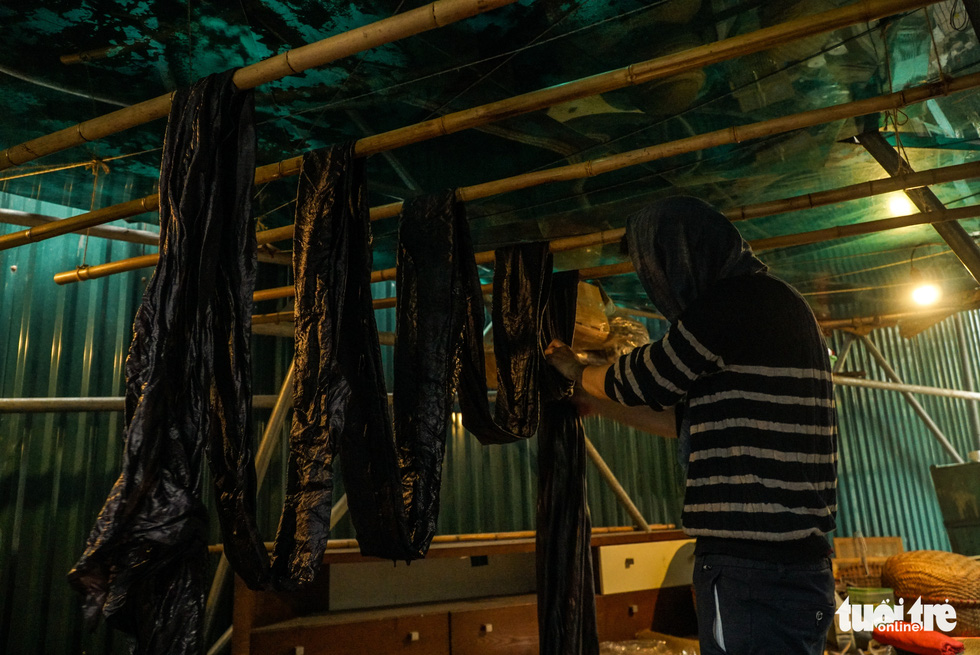Huy fell in love with creating natural fabric and coloring them with natural dyes the first time he set foot in a workshop.
It was on that occasion that he tried dying white silk and cotton with colors extracted from natural ingredients such as leaves and wood.
He was so successful that he decided to make the process his passion.
Huy recently returned to Vietnam from studying overseas.
“I majored in architecture and urban planning,” Huy shared.
|
|
| Brezel wood is the main ingredient in natural red dye. Photo: Nguyen Hien / Tuoi Tre |
“I was also interested in sociology and culture.
“The more I read, the more I enjoyed those subjects.
“I began studying Vietnamese history after I returned home.
“I really liked learning about ancient Vietnamese clothing.
“Ancient clothing has many pieces and accessories.
“It requires a lot of special fabric, most of which is expensive and must be imported from China and South Korea.”
|
|
| Dyeing fabric requires meticulous skill and steady hands. Just a small mistake can destroy a whole product. Photo: Nguyen Hien / Tuoi Tre |
Seeing an opportunity to carve a niche for himself in Vietnam’s ancient fabric market, Huy decided to try his hand at turning his passion into a career.
“Why don’t I dye the fabric myself?” he talked to himself.
According to the young man, dying fabric for ancient costumes is more challenging than doing it for normal clothing because the process involves creating colors from natural ingredients following directions described in historical documents and paintings.
In his two years of research and dye-making, Huy has made more than 50 colors.
He uses them to dye fabrics made from materials he finds in nature, such as silk, linen, or tussah silk.
Many of the colors are extracted from plants used in traditional medicines, fruit peels, and leaves, including from pomegranate, lychee, almond, wormwood, safflower, and brezel wood.
Though he seems to be a natural, he has also made many mistakes.
During one of his first dying experiences, he accidently damaged 20 meters of fabric because he dried it on aluminum wire.
That experience taught him to avoid drying fabric on metal surfaces and in high temperatures.
|
|
| Fabric is soaked in an iron salt solution to create a layer for color coating. Photo: Nguyen Hien / Tuoi Tre |
Every single step in Huy’s dying process is done by hand, resulting in only a modest volume of colored fabric each time.
A single strip of fabric must be dyed 14 to 20 times before it is fully colored. Occasionally, he must color a piece up to 100 times before it looks the way he wants.
A cloth of finished piece of fabric typically measures one meter in length and 60 centimeters in width. It can be sold for VND350,000 (US$15.3).
“In the future, I want to make fabric with patterns, not just solid colors as I am doing now,” Huy said.
“In the meantime, I will continue to study Vietnamese fabrics.
“Because organic and handmade fabrics are sold at high prices in different countries in the world, I think this is a great time to develop this kind of clothing in Vietnam.
“I want to make these products more affordable to Vietnamese people.”
|
|
| Safflower, a thistle-like annual plant in the sunflower family, is an expensive traditional medicine and natural material sold for VND1 million ($43.7) per kilogram. Photo: Nguyen Hien / Tuoi Tre |
|
|
| To dye a 20-meter-long strip of fabric, Nguyen Duc Huy must boil a kilogram of brezel wood for 30 minutes. Photo: Nguyen Hien / Tuoi Tre |
|
|
| Following the dyeing process, the fabric is dried in a cool place away from direct sunlight. Photo: Nguyen Hien / Tuoi Tre |
|
|
| Brezel wood is used as firewood after its color is extracted. Photo: Nguyen Hien / Tuoi Tre |
Like us on Facebook or follow us on Twitter to get the latest news about Vietnam!










